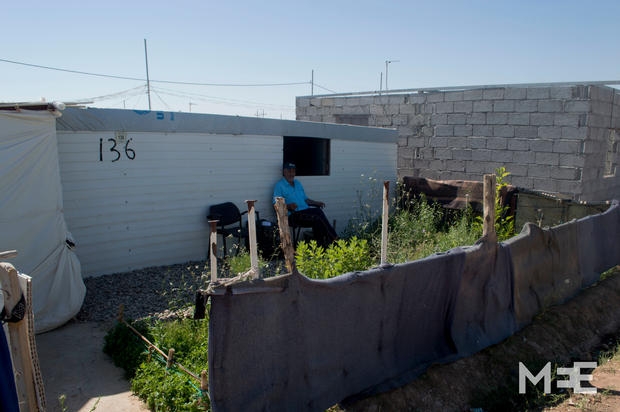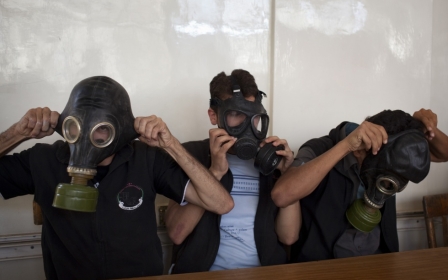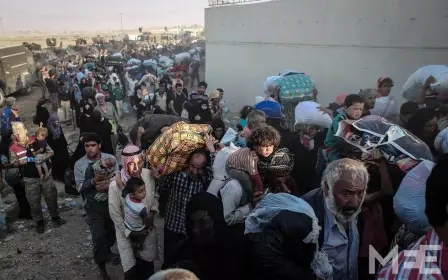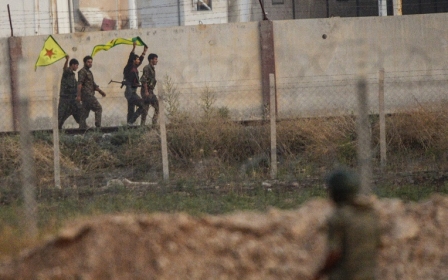Four years later: Syrian refugees in Iraq switch tents for concrete
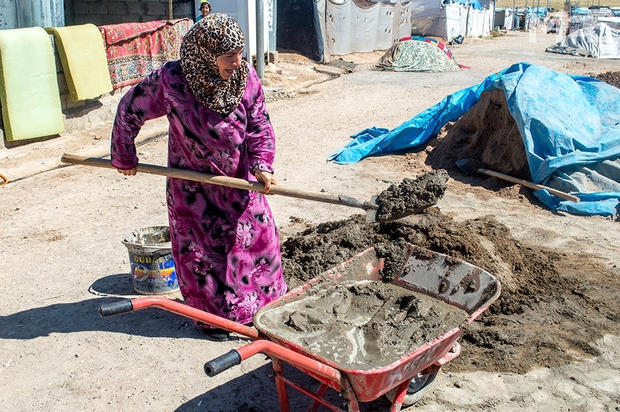
DOMIZ, Iraq – Sweat rolls down Sermin Hussein’s face as he sits down in the shade, out of breath from the gruelling work of mixing the thick, heavy concrete that will soon form a modest home. His brother takes over the mixing, while his father levels out a floor and his sister rushes back and forth with another bucket of water to be tossed onto the concrete mix. It’s a family affair.
“We’re building a city here,” Hussein jokes when he catches his breath again. “And in two years time it will be a better one than Dohuk.”
Dohuk, a large city in the Kurdish Autonomous Region of Iraq, lies just a few miles away, but the city isn’t about to face competition from an audacious city developer. Hussein is a refugee from Syria who has been living in Domiz Refugee Camp for the past four years. Now fed up with tents, Hussein's family, like most families at Domiz, has begun building for permanence.
Domiz camp used to house rows and rows of dirtied tents, battered by desert sand driven across the barren landscape. Today, inventive homes have been forged from bricks, corrugated metal, wood panels and the leftover remains of UNHCR-branded tents. There is one thing every home is missing however – a proper roof.
"We’re not allowed to build proper roofs, they [camp authorities] don’t want our houses to be proper houses yet,” Hussein explains, pointing to the flat wooden panel his family use as a makeshift roof. Throughout the camp, roofs have been fashioned from wood panelling and plastic sheets, all facing flat down – angled is not allowed. “I think they are trying to pretend this isn’t becoming permanent, that’s why they ignore everything else except roofs.”
Hussein also believes that the local Kurdish Regional Government (KRG) does not want them to settle in the region, instead hoping they’ll all return to Syria, and is putting pressure on camp officials and the UNHCR to stem the creation of fully fledged homes.
The camp, however, is already being formed into a makeshift city. Markets line the main street of the camp, branching off down subsidiary roads, where smaller shops have also begun to spring up. Wedding photographers, restaurants, shisha cafes, clothing stores and barbers – all with flat makeshift roofs – adorn the camp. “All we’re missing is a gold shop,” Abdelrahman Shindil, another resident of the camp, remarks to Middle East Eye with a wide smile, as he tends to his small corner market up one avenue off the main street. Shindil, from Qamishli in northern Syria, arrived four years ago with his wife and three young children.
“We were living in tents before, but then we bought this house about six months ago. After that I built my market next to it so I could have an income without leaving my family,” Shindil says, standing in front of a small market mostly full of sweets, sugary drinks and cheap household items.
The housing market in Domiz camp is booming and looks in no way like slowing. A tent and its allotted space can fetch upwards of $2,000. These days, however, tents are severely lacking in the camp. Over the past year, small concrete structures have taken over most of the camp’s space. A small, completed house with two bedrooms, a living room and kitchen, complete with small outside space for sitting or gardening can be bought for $4,000-7,000.
“We bought this place for $4,000,” Mohammed Aziz tells MEE, relaxing outside on a concreted sitting area with members of his family. The house has two small bedrooms, a kitchen, and a living room.
“For us this isn’t permanent though, we want to go back to Syria,” Aziz says. “Syria is our home, but for now we need to live, and a tent isn’t living.”
When a house goes on the market, usually when a camp resident is marrying outside of the camp, or because a refugee has gained permanent work and can afford to move, the house and plot is snapped up quickly. Technically this buying and selling within the camp is against the rules, but the refugees have come up with inventive ways to pass houses along to “relatives”, which is allowed, many refugees tell MEE.
Hussein is quick to insist people in the camp are not rich – families save up money from temporary jobs for years to be able to move to a small home, he says. What else can they do to make their lives a little more comfortable? he asks. “We can’t continue living in tents,” he tells MEE, reiterating sentiments shared across the camp.
“In the first year we were here we had hope we would return to Syria,” Hussein continues. “But now there is no hope. It’s over. The conflict and problems will just continue in Syria for who knows how long. So this here is now my home. It’s all we have, so we have to make what we can from it.”
Now Hussein lives at number 145 Hivi Quarter, Domiz Camp. New signs indicating street names and door numbers line the camp's roads. Small gardens are cropping up in front of structures tended to carefully by elderly family members, while children gather excitedly to help paint the walls of their new homes.
It is hard to deny that a new city of 70,000 people is being created here. The vast majority of refugees in Domiz are from Qamishli and its outlying areas in northern Syria, and old communities are being reformed and renewed. People don’t care so much for where they try and settle now in the camp. “Mostly people are just trying to live close to their friends and neighbours from back home,” Hussein tells MEE. It is almost as if Qamishli, with its pre-war population of just under 200,000, is being recreated in miniature form on one dusty plain in northern Iraq.
I’ll never truly feel at home here,” Hussein laments, even as he stands to continue the building of the solid concrete structure he will soon call home.
Hussein says sometimes he shudders at the thought of his future children calling this place home, looking down at the rows and rows of fledgling housing. He knows the possibility exists; the Middle East has seen this all before.
“I swear to God, as time passes our situation here will be the same as the situation was with the Palestinians; the camps will become permanent and they will become towns and cities like they did for the Palestinians. Palestinians started with tents, then started to build homes, and now we are doing the same. It will be like the Palestinian camps we know in Syria.”
New MEE newsletter: Jerusalem Dispatch
Sign up to get the latest insights and analysis on Israel-Palestine, alongside Turkey Unpacked and other MEE newsletters
Middle East Eye delivers independent and unrivalled coverage and analysis of the Middle East, North Africa and beyond. To learn more about republishing this content and the associated fees, please fill out this form. More about MEE can be found here.




